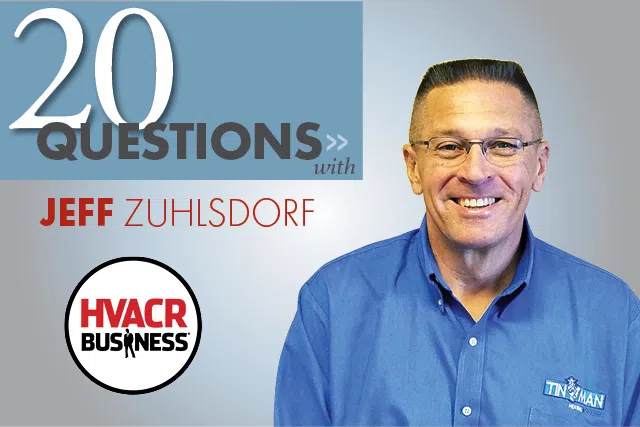Terry Tanker recently sat down with Jeff Zuhlsdorf, owner of Tin Man Heating & Cooling in Bowling Green, Ohio, a 2017 Tops in Trucks Fleet Design Contest winner. Zuhlsdorf started his company in 1988. The two discussed rebranding the company, the importance of planning, the keys to growing his business and much more.
1. Congratulations on being a Tops in Trucks winner — how many vehicles are in your fleet?
Thank you, we’re thrilled. We have a Ford Van, four Chevy Vans, a GMC Van, a Ford Box Truck, a GMC Box Truck and a Dodge Ram.
2. How did you come up with the idea for this fleet design?
I hired a design firm and they wanted to change our logo. I said I was open to that, and we went back and forth several times before we came up with the final design.
3. Have you seen a return on this investment?
The investment is $2,400 per vehicle, and it’s a bit too early to tell. We are turning a lot of heads in traffic, however, and customer feedback has been great. Our employees really like it as well.
4. If you could go back and start the process over again, what would you do differently?
I would have started wrapping the fleet sooner. No other company in the area has a wrapped vehicle and I’m sold on the fact that our vehicles are our best marketing tool, both short- and long-term.
5. What is your background?
I started in the industry more than 30 years ago as a commercial refrigeration service technician and I really enjoyed it. I started Tin Man without a lot of business experience and had to learn through trial by fire (laughs).
6. Last year Tin Man grew by 36 percent — what are you doing differently?
I was much more consistent with regard to business planning and strategy. Instead of jumping around, I stuck with one plan. Lots of times, I’ve found myself trying to implement too many things and never giving them enough attention. So, I simplified the approach and it really worked.
7. Was it profitable growth?
Yes, it really was. Our bottom line was 15.6 percent.
8. Formerly, did you have a business plan?
In my mind, yes (laughs). It’s different getting it on paper. Life happens, problems pop up and you get side-tracked and the next thing you know, you’re trying something different. Rather than jump around, its best to stick with “a” plan. And, if you find you need to make an adjustment or two that’s fine — just don’t start something new.
9. For others without a plan, what advice do you have?
They are essential. When you go on vacation, you’ve got a map, you’ve got a plan. You don’t simply get in the car and say, “Well, I guess we’re pointing this way, so off we go.” Sports teams may be the best analogy. They have an executable plan for each game and, typically, the team with the best execution wins the game. Business planning is exactly the same.
10. What are the major elements of your plan?
We use the flat rate plan, and we’ve invested in more training for the service technicians on how they present themselves in the home, as well as being more open minded in presenting issues the customer could face in the near future.
11. Could you explain this approach?
I like to use this analogy: When you’re at the doctor’s office because your leg hurts, he doesn’t just check your leg. He checks your blood pressure, temperature, pulse and more. We want to do the same, and check out the whole system and give the customer a system evaluation so they have options.
12. Does this build trust with the customer?
Nothing disappoints a customer more than when a contractor fixes a problem only to find out three months later there is another one. We want them to be aware of potential future issues too. Then they decide if they want that problem addressed now or in the future.
13. What do your technicians typically find?
Simple things like faulty capacitors. They have a high failure rate or they’re out of tolerance but the system is still running. It’s kind of like a light bulb. We don’t know when it’s going to fail, but it will. With some simple tests, we can check these things. Today, convenience for the customer is everything and it’s a nuisance for them if we have to make additional service calls. We try to give them a system assessment, make a recommendation and then let them decide what they’d like to do.
14. What is your business mix?
We’re 100 percent residential maintenance, repair and installation. We sell Amana, Armstrong and WaterFurnace geothermal.
15. What is your company’s sales approach?
Let customers know we’re there to service their system and we have a complete 80-point check we go through which helps us make recommendations to them today and alert them to any problems we think they may encounter in the future.
16. Are you concerned customers will think you’re trying to sell them more than they need?
We’re aware there are companies who try to take advantage of customers. I tell our guys there’s enough failure out there that’s honest failure. We don’t need anything extra. Most importantly, we can show them with test tools why we’re making the recommendations. We have the proof.
17. How is recruiting in your area?
Like most companies, it’s difficult. Our future growth is dependent on finding individuals with some technical interest. I’m always looking for those with good communication skills because we can teach the technical skills they need.
18. Where do you do your training?
We do it right here on site. We’re building a new training room. Our current training room is for soft skills, but we’re building a technical training area above our warehouse.
19. Do you use GPS in your service vehicles?
Yes, about five years ago I felt like it was time to make the investment. It manages your two most expensive assets in your company: your vehicles and your people.
20. Are you working on any other major projects this year?
In addition to the training room, we’re revamping our PO system to help control spending, which I think should be a fairly quick fix. I’m also working on getting a better handle on our warehouse inventory and tracking. I realize this is important and dollars are evaporating, so I’m committed to getting it fixed.






